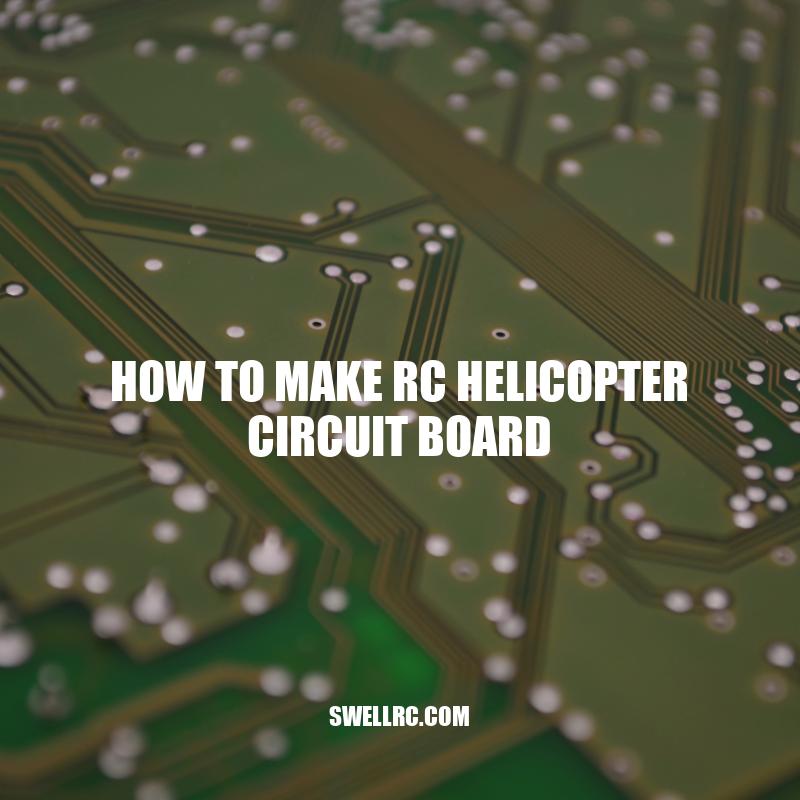DIY Guide: Making Your Own RC Helicopter Circuit Board
Remote control (RC) helicopters have become increasingly popular among enthusiasts who love to fly them and even create custom designs. Making an RC helicopter circuit board is an essential step in building a helicopter that meets your specifications. The circuit board serves as the foundation for the electrical components, enabling you to control the helicopter’s movements and operations with ease. Designing and creating your own RC helicopter circuit board can be a fulfilling and rewarding experience. It allows you to tailor your helicopter for specific purposes such as navigating tricky terrains or performing aerial stunts. However, making your circuit board can seem like a daunting task if you’re new to RC helicopter building. Fear not, as this article will guide you through the process of making an RC helicopter circuit board from start to finish. In this guide, you will learn about the materials required, the design process, transferring the design, etching the circuit, drilling, assembling the board, and much more. With some basic knowledge and the right tools, you can make your circuit board and have your customized RC helicopter up and running. Let’s dive right in!
Gathering Materials and Tools
Before you can begin designing your circuit board, you will need to gather the necessary tools and materials. Here is a list of what you will need:
- Copper-clad board
- Etchant solution
- PCB (printed circuit board) design software such as Eagle PCB or PCB Artist
- Printer
- Laser printer toner
- Iron
- Drill machine
- Soldering iron and solder
- Various electronic components such as resistors, capacitors and transistors
- Gloves and goggles for safety
You can find most of these materials at your local electronics store or online retailers such as Amazon, Sparkfun or Digikey. Some online resources that can help you with designing your circuit board include Online PCB Calculator and EasyEDA. Once you have everything you need, you’re ready to start the process of designing your circuit board.
How do you make a circuit board design?
To make a circuit board design, follow these steps:
- Choose a software program for drawing the circuit board design.
- Create a schematic diagram of your circuit.
- Design the layout of your circuit board.
- Print out your circuit board design and transfer it to the top layer of the copper-clad board using a laser printer, iron, and transfer paper.
- Etch the board to remove the unwanted copper.
- Drill holes for components and connectors.
- Install the components and connectors.
There are many software programs available for making circuit board designs, such as Eagle PCB Design Software, KiCAD, and EasyEDA. Additionally, there are companies that offer custom circuit board design services, such as PCB Design Pros and Sierra Circuits.
Designing the Circuit
The design of the circuit is a critical step in creating your RC helicopter circuit board. Here are some tips to help you design your circuit board effectively:
- Start by creating a schematic of the circuit. This schematic represents the complete design of the circuit on paper so that you can use it as a reference later.
- Use a PCB design software such as Eagle PCB or PCB Artist to turn your schematic into an actual design.
- Keep in mind that the size of your components will directly affect the size of your board.
- Try to keep your traces as short as possible to minimize resistance and therefore maximize performance.
- Consider adding extra components such as LEDs or buzzer alarms for added functionality and excitement.
- Test the design before going through the process of printing and etching the board to save time and materials.
There are many online resources available to help with designing your circuit board such as PCB Web Designer or DipTrace. It’s also important to keep in mind that there are different types of circuit boards available, each with its benefits and drawbacks. A single-sided board is more straightforward and cheaper to produce, while a double-sided board allows for more complex circuits and components. Here is a table summarizing the differences between the two:
| Single-sided board | Double-sided board | |
|---|---|---|
| Cost | Cheaper to produce | More expensive to produce |
| Circuit complexity | Limited to simple circuits | Allows for more complex circuits and components |
| Space requirements | Requires more space for larger components | Requires less space for the same components |
How to Design a Circuit Board for PCB?
Designing a Printed Circuit Board (PCB) requires knowledge of electronic components, software tools, and a systematic approach. Here are the basic steps to design a circuit board for PCB:
- Step 1: Create a schematic diagram using a software tool such as Eagle or Altium.
- Step 2: Convert the schematic into a PCB layout using the same software tool.
- Step 3: Place components on the PCB layout, considering their size, shape, and connection points.
- Step 4: Rout the connections between components, ensuring they meet electrical and physical requirements.
- Step 5: Add any required text, labels or logos on the PCB.
- Step 6: Verify your design before printing a physical prototype.
To learn more about designing PCBs, you can check out websites such as ElectroSchematics.com and products like the Altium Designer software.
Printing the Design
Once you have finished designing the circuit, the next step is to print the design on the transfer paper. Here are some tips to help you print the design effectively:
- Use a laser printer that produces high-quality prints with toner-based ink.
- Print using “draft” or “fast mode” in the printer settings to reduce the amount of toner used.
- Use a glossy or glossy photo paper to print the design since it has the ability to transfer toner more effectively to the copper-clad board.
- Be sure to print the design in mirror or reverse mode to ensure that the image appears correctly when ironed face down onto the copper board.
- Ensure that the size of the print matches the size of the copper board to avoid errors when transferring the design.
- Use the original print and not a copy to ensure that the dots and lines are complete and not broken.
There are testing kits available to check if your printer has printed the design correctly, such as the Toner Transfer Paper for DIY PCB (Printed Circuit Board) Kit. It’s also a good idea to practice printing designs on plain paper before printing the final design on the transfer paper.
How do you print designs on heat transfer paper?
To print designs on heat transfer paper, you will need the following supplies:
- Heat transfer paper
- Inkjet printer
- A design software or app
- A heat press or iron
Once you have your materials ready, follow these steps:
- Design your image or text on your chosen software or app.
- Print your design on the heat transfer paper using an inkjet printer.
- Trim the design to remove any unnecessary white spaces around the design.
- Preheat your heat press or iron to the appropriate temperature.
- Place your T-shirt or other fabric on the heat press or ironing board.
- Place the printed heat transfer paper on top of the fabric with the design facing down.
- Press the heat press or iron firmly onto the design for the recommended amount of time.
- Carefully peel away the backing paper from the design.
It is important to note that heat transfer paper comes in different types and qualities. Before purchasing, make sure to read reviews carefully to select the one that will suit your needs best. Some popular brands for heat transfer paper include Avery, Cricut and Neenah.
Transferring the Design
Once you have printed the design, the next step is to transfer it onto the copper-clad board. Here are some tips to help you do this successfully:
- Clean the copper board thoroughly with a fine sandpaper and then wipe it clean with a tissue or a cloth.
- Place the printed transfer paper face down on the cleaned copper board.
- Iron the transfer paper onto the board, applying adequate pressure and heat for at least 4-5 minutes. Use a flat and stable surface to iron the board and not your work table which may warp or deform the board.
- Peel off the transfer paper slowly to avoid ripping off the toner during the transfer.
- Use acetone or nail polish remover to clean remaining toner areas if required.
- Ensure that no dust particles accumulate on the toner – this can cause the etching solution not to work effectively.
If you’re having trouble transferring your circuit design, there are many online forums and communities available to help. Check out online communities such as r/PrintedCircuitBoard on Reddit, PCB Design Forums, and EEVblog Forum. These communities are populated by experts and enthusiasts that might provide invaluable tips and advice.
How do you etch a copper clad board?
To etch a copper clad board, follow these steps:
- Clean the copper surface with acetone to remove any grease or dirt.
- Print the circuit design on a glossy paper with a laser printer. Ensure that the paper is printed in mirror mode as the design will be transferred upside down on the copper board.
- Place the printed paper on the copper board with the print facing down.
- Iron the paper for about 5 minutes until the toner melts and transfers to the board.
- Soak the board in ferric chloride solution until the exposed copper is dissolved, leaving the printed circuit design intact on the board.
- Rinse the board with water and remove the toner with acetone.
- Drill holes where necessary and the board is ready for use.
There are various products and online tutorials available for etching copper clad boards. Check out websites such as Instructables, Adafruit or Sparkfun for more information.
Etching the Circuit
Etching the circuit is a crucial step in making an RC helicopter circuit board. Here are some tips to help you etch your circuit board correctly:
- Prepare a solution of ferric chloride or an etching solution and carefully place the printed copper-clad board into the etching solution.
- Stir the solution intermittently to prevent any stagnant areas.
- Monitor the etching process frequently to ensure that the circuit lines are being etched away properly.
- Caution: The etching solution is highly corrosive, and proper safety precautions should be taken. Wear gloves and safety goggles, and etch in a well-ventilated area.
- Clean the board with water and remove the transfer paper with acetone or nail polish remover.
If you’re having trouble with the etching process, you can seek help from experts and professionals online. Websites such as Instructables and PCBWay have detailed tutorials on how to etch and assemble your circuit board. There are also many YouTube channels such as GreatScott, Mr. Carlson’s Lab, and Julian Ilett that offer video tutorials and insight into the etching process.
Why is my RC helicopter not lifting off?
There could be several reasons why your RC helicopter is not lifting off. Some of the most common reasons include:
- Low battery power
- Improper blade balance
- Damaged rotor blades
- Incorrect transmitter settings
- Wrong center of gravity
Before attempting to troubleshoot the issue, make sure to read the instruction manual thoroughly. If you are still experiencing problems, try contacting the manufacturer’s customer support for assistance.
There are also several online forums where RC enthusiasts share advice and tips on how to maintain and troubleshoot your RC helicopter. These websites include RC Groups, RC Universe, and Helifreak.
Drilling and Assembling
After etching your circuit board, the next step is to drill and assemble the components. Here’s what you need to know:
Drilling
- Choose the appropriate size of the drill bit for your board.
- Drill straight down into the board, and avoid wobbling or tilting the drill bit.
- Remove any burrs or rough spots around the holes using sandpaper or a file.
- It’s also essential to blow out all the debris or dust from the board before assembling any components.
Assembling
- Take your time to assemble all the necessary components properly.
- Place the components on the board and ensure they align correctly.
- Use a soldering iron and solder to connect the leads or pads on the board and the component.
- Be careful when soldering, so you don’t damage any components or overheat your board.
- Test your finished circuit board by plugging it into your RC copter and ensure that all the controls and connections are working appropriately.
If you’re interested in taking your RC helicopter circuit board making to the next level, you can build and program your circuit board using Arduino. Arduino is an open-source electronics platform that lets you create interactive electronic circuits. Websites like SparkFun or Adafruit provide a wide range of Arduino tutorials to help you learn how to program your RC helicopter circuit board.
How to make printed circuit board?
To make a printed circuit board, follow these simple steps:
- Create a schematic diagram of the circuit using software such as Eagle PCB or Altium Designer
- Transfer the schematic into a PCB layout software such as KiCAD or DipTrace
- Design the layout, including component placement and trace routing
- Export the layout to a Gerber file format
- Send the Gerber file to a PCB manufacturer
- Receive the manufactured PCB board and solder on your components
There are many websites and products available that can assist in the process of making a printed circuit board, including PCB manufacturers such as JLCPCB and PCBWay, and software such as Eagle PCB and KiCAD.
Conclusion
In conclusion, making an RC helicopter circuit board requires patience, attention to detail, and a few specialized tools. Hopefully, this guide has given you the necessary steps and knowledge to design and build an RC helicopter circuit board. Building your RC helicopter is both a rewarding and satisfying experience that can improve your knowledge and understanding of electronics.
As with any skill, the more you practice, the better you’ll become, and the more complex projects you’ll be able to undertake. Don’t give up if your first attempt doesn’t turn out as expected. Keep trying, and you’ll soon be able to build more complicated designs and circuits for your RC helicopter.
If you’re interested in learning more, there are many online resources available on the internet. Websites such as Instructables, Makezine, and YouTube provide comprehensive tutorials on building RC helicopters and making circuit boards.
Finally, remember to always follow safety guidelines when working with electronics and chemicals. Wear gloves and goggles, work in a well-ventilated area, and keep your workspace clean and organized.
Now that you know how to make your RC helicopter circuit board go ahead and design, print, transfer, etch, drill, and assemble your board. With a little bit of effort and patience, you can design custom circuit boards for your RC helicopter that will take your flying experience to the next level. Good luck!



